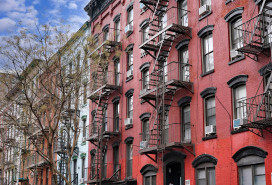No strings attached: Inside the world of pied-à-terre rentals

Pied-à-terres get a lot of heat as a haven for foreign money in NYC, and indeed, this part-time living setup is typically associated with buyers, not renters (though that comes with its own set of caveats and complications). But for some who take the plunge—increasingly, empty-nesters from nearby suburbs opting to give up their spacious homes for a faster-paced lifestyle in city centers, according to a recent article in the New York Times—it might make more sense to hang on to their houses in the burbs and simply rent a place in the city instead. But, like so much of New York City real estate, it's complicated:
What empty nesters want from pieds-à-terre
Andrea Saturno-Sanjana, a salesperson with Citi Habitats, says she has worked with many such clients. One couple, for instance, live and work in a New York suburb but also do business in Manhattan. After their children left for college, they opted to downsize to a smaller condo in their community, as well as rent a pied-à-terre downtown for a year, to see how they liked it before making a more significant commitment to city living.
Saturno-Sanjana says clients like them often have criteria that longtime New Yorkers do not: Having spent so much time at a distance from the city, they now want to reside somewhere that screams Manhattan, complete with views of iconic skyscrapers, or even the Statue of Liberty. “It’s sort of like, ‘I don’t want to feel like I’m in Hoboken or Williamsburg,’” Saturno-Sanjana says. “‘I want to know that I’m in Manhattan.’ So there’s a little cachet with that.”
One mistake that arises with pied-à-terre seekers who have lived outside the city for many years is that they begin their search based on memories of neighborhoods that no longer exist. “They remember, oh we used to come in and go to the Limelight,” Saturno-Sanjana says. “The people who are coming in fresh, who haven’t been commuting, they really start with that nostalgia and then because the neighborhoods have changed and other things have opened up to them, they often don’t end up in that neighborhood.”
Plus, she says, many of these renters aren't willing to fully relinquish the amenities of life in the burbs. Their pied-à-terre “has to have very particular things. We’re not talking about a walk-up,” she says, and might be kitted out with amenities such as in-apartment washers and dryers, concierge services, and plenty of storage space.
Challenges for pied-à-terre renters
That said, finding a place that fulfills all these prerequisites can be a tall order—especially for people on fixed incomes. Jeffrey Geller, Vice Chairman and COO of Insurent Lease Guaranty, which guarantees leases for thousands of NYC renters each year, cautions that retirees who are pied-à-terre hunting should expect they’ll need a guarantor. [Full disclosure: Insurent is a BrickUnderground sponsor.]
“Ninety-nine percent of landlords will not qualify people in cash liquid assets,” Geller says. “Because landlords qualify people based on income and good credit, they would rather take a person that made 50 times the rent and had $5,000 in the bank than a person that was retired but had a million dollars in the bank.”
Retirees may be tempted to offer additional security or pre-paid rent if they can’t demonstrate salaries that are 40 to 50 times the monthly charge, which many landlords in New York require. But, Geller says, if they're looking for a pied-à-terre in a newer building that has a 421a tax abatement—which developers received as an incentive to encourage construction—they won’t be legally permitted to pay extra up front.
“Because the city of New York gave them tax benefits, they fall under rent stabilization,” Geller says, which means that it’s illegal for the buildings to accept additional security or rent. “That’s a major problem. In the other buildings that don’t fall under rent stabilization, obviously an older person can say, 'Here’s five months security, here’s 12 months rent.' But who would really want to do that if they don’t have to? Renting in New York City is tremendously difficult. Rents are high, and very hard to qualify on income.”
On the other hand, renting a pied-à-terre rather than buying has its advantages. After decades in comparatively spacious suburban homes, many of her clients, Saturno-Sanjana says, have trouble downsizing. While city living has tremendous appeal to these apartment-seekers, she says it’s important that they ask themselves: “Can I really live in a smaller space with less stuff?” If not, renting may be their best route.
Related:
Buy-curious: I'm in the market for a pied-à-terre. What do I need to know?
BrickUnderground's pied-à-terre checklist: what to consider before buying a part-time place in NYC

























